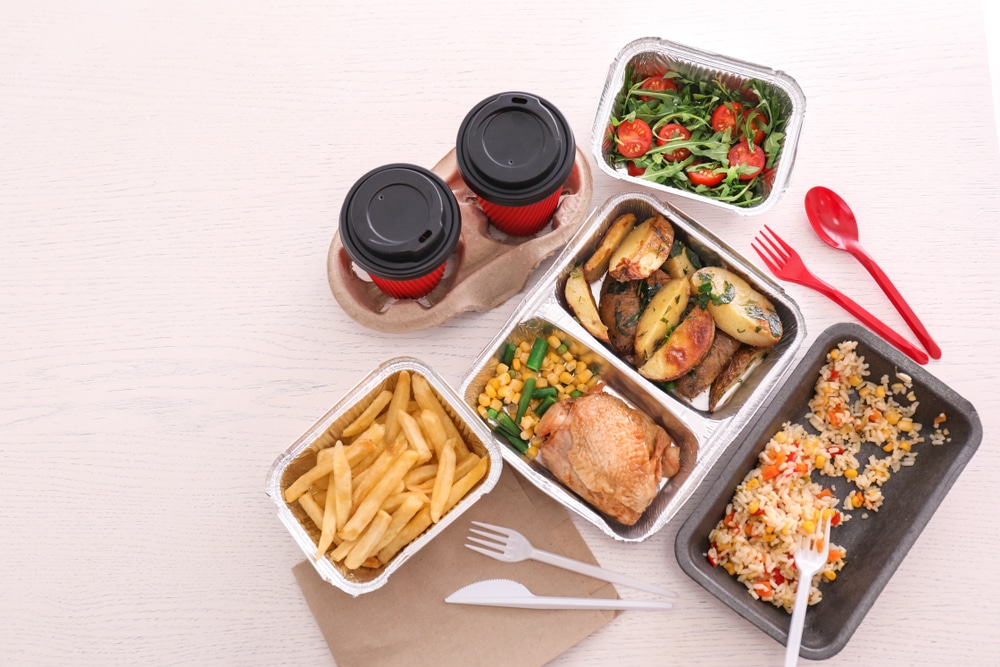The microwave is one of the most beloved conveniences of the last 70 years, and it continues to be a staple of every existing and newly built kitchen today. It is perfect for those who need to heat something quickly without fussing with the stove or a more complicated appliance.
Since microwaves are so common, some people have considered them to be a catch-all for anything that needs to be warmed. However, caution is necessary when using a microwave. Put in the wrong food, and it could melt. Put anything non-edible inside, and you could be looking at damage to your home or injury to the operator.
To keep you safe and sound, we have compiled a list of items that you should never put in your microwave.
1. Plastic Containers

When many people think about microwaves, the first thing that often comes to mind is reheating leftovers at home or at the office kitchen. However, reheating food the wrong way can cause more harm than good. One common misdeed is microwaving food in plastic containers.
When you heat plastic, it releases phthalates and Bisphenol A, also known as BPA, which are the components that give plastic its appearance and durability. The problem is that these chemicals can leak into your food and affect your body’s hormones, an effect that has been leaked to many types of conditions, including diabetes, obesity, and reproductive issues. Plastic containers include products like those made by Tupperware but also extends to plastic drinking glasses and baby bottles.
2. Aluminum Foil

While it may seem easy to throw your leftovers in the microwave in the aluminum foil they were sitting inside of in the refrigerator, foil should never be placed in the microwave. Take the food and put it on a microwave-safe plate instead.
The main issue is that aluminum foil is metal, and when heated, the radio waves inside the devices can cause the metal to catch fire or create dangerous sparks. Metal containers, in general, will not work in a microwave, and the reason is because the reflective metal sides of the microwave are not meant to heat metal. So foil, metal cans, and metal containers will also either not heat up at all or cause sparks that could lead to a kitchen fire.
3. Clothing

The microwave has become such a fixture in our lives that we forget that it is intended for heating food and food alone. Some people may have the idea of using the heat that the microwave creates to dry their clothes if they are in a pinch, but this is not recommended.
In reality, it actually comes down to the type of fabric. Clothes that are made completely out of cotton are considered microwave-safe. However, most clothing is made of elastic and polyester, and you do not want to put those items in the microwave as they are flammable and likely to catch on fire. Keep in mind that a microwave will not dry your clothes. It will only make the fabric hotter, so use caution when removing them if you must use the microwave.
4. Grapes

Microwaves are interesting devices, and they create unique effects on certain foods, and grapes are very interesting but often dangerous. Don’t put grapes in the microwave, especially those that still have the skin attached. When you do, the microwave will heat the grapes to such an extent that the skin will catch fire, if only for an instant. After that, the grape essentially liquefies into a plasma. Obviously, you would not want to eat them at this point.
Beyond the unique science experiment that grapes in the microwave create, the act can also become dangerous. The electricity causing the grapes to set fire also sends out sparks which could ruin the appliance. There is also the risk of fire damage to your kitchen if things get out of hand.
5. Breast Milk

Some parents may have the inclination to place their baby’s bottle in the microwave, even for a few seconds, to warm it up before a feeding, but this is strongly discouraged for a couple of reasons.
For one, some parents choose to feed their children breast milk because of the plethora of benefits, including a lower risk of many diseases, including future breast cancer, diabetes, cardiovascular disease and more. Studies have shown that microwaving breast milk can diminish the nutritional components that make breast milk so healthy, thus defeating the purpose.
Possibly the more important reason not to microwave breast milk is that the appliance is not designed for that purpose. The machine will not heat up all of the milk as a whole, but instead, just bits and pieces. So some of the milk may be cooler, while other portions can be very hot and can hurt the baby.
6. Eggs

While you may be looking for a quick snack, cooking hard-boiled eggs in the microwave is a bad idea. The device will make the eggs very hot, and because they are a closed shape, there is nowhere for the heat to escape, and they can easily explode all over your microwave. If eaten, they can be too hot and can burn your fingers or your mouth.
The best way to cook your eggs is over a stove with medium heat. When the heat is too high, the eggs can dry out and become inedible.
7. Hot Peppers
At first glance, hot peppers and microwaves might seem to be a likely pair, but you should never put peppers in to cook. The ingredients in peppers make your mouth hot, but when put in the microwave, those same elements can cause you harm.

Hot peppers like jalapenos, cayenne peppers, and chili peppers are made hot by an ingredient called capsaicin. This is fine for adventurous eaters, but the microwave heats peppers to such an extent that it creates a form of “pepper spray that is contained within the closed device. When you open the microwave door, that essence will come out and into your face and likely burn your skin.
On top of that, peppers will also heat up very quickly in the microwave, and even if they don’t emit that aerosol, they will burn your hand or mouth.
8. Travel Mugs

Travel mugs should only be put in the microwave if the packaging informs you that doing so is safe. If not, you will see negative side effects based on the type of mug you use.
For plastic travel mugs, the microwave will apply quick heat that will begin to melt the cup. On top of that, when plastic mugs are heated, they release dangerous chemicals, similar to what happens when you cook reusable plastic containers.
Metal travel mugs that are not microwave-safe can be even more dangerous. Many microwaves are made out of stainless steel, and the heat within will warm the outside of the mug instead of the liquid inside. Not only does this defeat the purpose, but the hot metal could create a spark and fire damage.
9. Restaurant Takeout Containers

Regardless of which restaurant you frequent or the way they pack your leftovers, you likely want to avoid reheating the food in the container it came in, as each type of container can have its own negative side effects.
Styrofoam may be one of the worst substances you can have in a home or office kitchen for many reasons. For one, it is bad for the environment and cannot be recycled. Beyond that, styrofoam also contains harmful chemicals, including polystyrene, and when heated, the chemical leaks into your food. These chemicals have been found to lead to cancer in humans and animals.
Another take-home container that you should be wary of is oyster boxes, which is the official name of the square carry-out containers often provided at Chinese restaurants. The real issue with these containers is that they have a metal handle that can cause sparks when heated. When you take the container out of the microwave, the metal can also burn your hand.
When it comes to reheating food, your best and safest option is to take the food out of the container and cook it in the microwave on a paper towel.
10. Processed Meats

When it comes to processed meats like hot dogs, sausages, and lunch meats, it is a smart idea to keep them out of the microwave. These foods are not meant to be heated this way, and when they are, they can increase the chances of cholesterol oxidation, which is known for many negative health impacts on the arteries and can lead to coronary heart disease, among other ailments.
11. Nothing

It should go without saying, but you should never run the microwave for any length of time if it is empty.
Microwaves work by literally creating “microwaves” that emit from a component called a magnetron to heat your food. When you turn a microwave on without anything inside, the waves have nowhere to go, and at a minimum, it will cause the microwave to malfunction. Accidentally pressing the start button and then turning it off a second later might be okay, but by keeping it on, the microwave could start a fire in your home.

